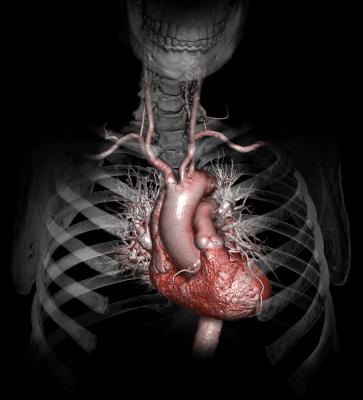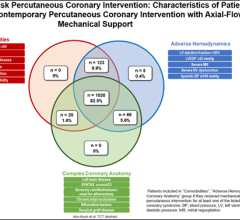
May 23, 2016 — Patients with a combination of left ventricular dysfunction and low aortic valve gradient have higher mortality rates and a greater risk of recurrent heart failure after transcatheter aortic valve replacement (TAVR). A new study published in the Journal of the American College of Cardiology points to low aortic valve gradient, or reduced force of blood flow through the aortic valve as the driving force behind their poor outcomes.
Patients with this profile, however, should still be considered for TAVR, especially since research on similar patients who had surgical valve replacement found that they could withstand the procedure, Suzanne J. Baron, M.D., M.Sc., the study’s lead author, said.
Low aortic valve gradient is a result of aortic stenosis, a narrowing of the opening of the aortic valve. This condition results in restricted blood flow from the left ventricle to the aorta, the body’s main blood vessel. Stenosis can also lead to impaired left ventricular ejection fraction, meaning that the heart pumps an inadequate amount of blood with each beat.
To treat aortic stenosis, physicians typically replace the aortic valve, either through open-heart surgery or through TAVR. During TAVR, a new valve is delivered to the heart through arteries in the leg or chest. For patients at high risk of surgical complications, TAVR has been shown to be at least as effective as open-heart surgery.
Previous studies of valve replacement through surgery have shown that patients with impaired left ventricular ejection fraction and low aortic valve gradient do not do as well as those with better cardiac function and blood flow. In this study, researchers set out to determine the roles that left ventricular dysfunction and low aortic valve gradient play in rates of death and recurrent heart failure following this less invasive procedure.
Using data from the Society of Thoracic Surgeons/American College of Cardiology TVT Registry linked with Medicare claims data, researchers examined records from 11,292 patients who had this procedure performed between November 2011 and June 2014. Patients were placed in three categories for left ventricular function: severe left ventricular dysfunction defined as an ejection fraction less than 30 percent; mild to moderate dysfunction, ejection fraction between 30 and 50 percent; and preserved left ventricular function, for patients with an ejection fraction greater than 50 percent. Low aortic valve gradient was identified as less than 40 mmHG, with high aortic valve gradient defined as greater than 40 mmHG.
Researchers first looked at the impact of each variable separately. At the one-year mark, the study found that aortic stenosis patients with severe left ventricular dysfunction treated with TAVR had the highest mortality rate, compared to patients with left ventricular function closer to normal: 29.3 percent vs. 21.9 percent. Similarly, patients with a low aortic valve gradient had a higher one-year mortality rate than those with a high aortic valve gradient: 27.1 percent vs. 21.5 percent.
Researchers also looked at left ventricular function and aortic valve gradient together. They found that patients with a combination of preserved left ventricular function and a high aortic valve gradient had the most favorable clinical outcomes at one year, with a mortality rate of 23.6 percent and heart failure at 11.2 percent. Patients with severe left ventricular function and a low aortic valve gradient had the least favorable clinical outcomes, with a mortality rate of 33.1 percent and heart failure at 23.6 percent.
Since left ventricular dysfunction and low aortic valve gradient are often seen together, researchers aimed to determine which of these factors was the driving force behind the poor clinical outcomes. After adjusting for several clinical factors — including age, sex, previous cardiovascular bypass grafting and previous angioplasty — only the presence of a low aortic valve gradient was associated with higher mortality rates and recurrent heart failure. The effect of left ventricular ejection fraction was no longer significant.
Baron, a cardiologist at Saint Luke’s Mid America Heart Institute, University of Missouri-Kansas City, said the finding that left ventricular dysfunction was not independently associated with long-term mortality after adjusting for clinical factors “provides important reassurance regarding the benefits of TAVR, even in patients with severe left ventricular dysfunction.”
The study results also suggest that patients with a low aortic valve gradient may be a subset of aortic stenosis patients who have less long-term benefit from this procedure, although the majority of these patients who were still alive one year after the procedure had improved quality of life. Baron concluded that “neither severe left ventricular dysfunction nor low aortic valve gradient alone or in combination provide sufficient prognostic discrimination to preclude treatment with TAVR in the absence of other adverse prognostic factors.”
In an accompanying editorial, Philippe Pibarot, D.V.M., Ph.D., FACC, Canada Research Chair in Valvular Heart Diseases at the Quebec Heart & Lung Institute, and John Webb, M.D., director of interventional cardiology, the cardiac catheterization laboratories, the interventional fellowship training program and the interventional cardiology research group at St. Paul’s Hospital, in Vancouver, British Columbia, noted some limitations of the study, including the lack of information on other important hemodynamic variables, such as transvalvular flow, which is a reflection of the flow of blood across the aortic valve, in the TVT Registry. As a result, the authors were not able to distinguish patients with low flow from those with normal flow, who generally have better outcomes.
That said, they agreed that the presence of a low-gradient, low-left ventricular ejection fraction and/or low flow “should not preclude the consideration of aortic valve repair but should be interpreted as a marker for higher risk of procedural and post-procedural complications and adverse events.” They suggested that “individualized risk stratification be required to determine the best type and timing of therapy for a given patient with low-gradient severe aortic stenosis.”
For more information: www.acc.org


 April 17, 2024
April 17, 2024 








